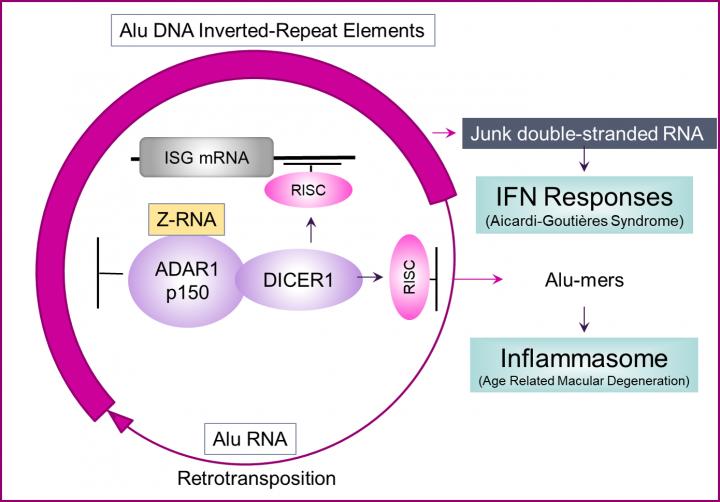The unexpected role of junk nucleic acids in cancer

Credit: InsideOutBio
In an article just published by Trends in Cancer online, Dr. Alan Herbert, founder at InsideOutBio, highlights how the way cancer cells solve the problem of junk RNA makes them vulnerable to a new type of cancer therapy.
DNA mutations are not enough for cancer cells to keep growing. They need to fix a number of other problems as well. One challenge is dealing with the junk RNA that accumulates when cancer cells go wild and make RNA indiscriminately. In normal cells or those infected with virus, such high levels of junk RNA cause cell-suicide or elimination by the immune system. Tumors survive their junk RNA problem by preventing these responses. They exploit an enzyme known as ADAR that helps eliminate the junk RNA threat. Overall, about 40% of tumors are dependent in vitro on ADAR for their survival (for some tumor types it is as high as 80%). When ADAR is inhibited, those tumors die just as a normal cell would. Targeting ADAR is a novel approach for treating cancer. The discoveries represent a major advance in our understanding of tumor biology and reveal new ways to defeat cancer.
Checkpoint inhibitors (CPIs) are the mainstay of modern cancer immunotherapy. They work by amplifying immune responses against tumors. The 2018 Nobel Prize award recognized their discovery. ADAR causes CPIs to fail by silencing immune responses. Inhibiting ADAR improves responses to CPIs in mouse cancer models and promises another huge advance in improving cancer survival.
ADAR is unusual because it binds to double-stranded Z-DNA and to double-stranded Z-RNA that twists to the left rather to the right (as it does in Watson-Crick DNA). Recognition of Z-DNA and Z-DNA targets ADAR enzyme to RNAs that it attacks. Mutations that prevent Z-DNA and Z-RNA recognition by ADAR produce immune activation. Drugs designed to inhibit ADAR function should act in the same way and stimulate immune responses against tumors. Targeting one particular variant of ADAR (the p150 isoform) will be highly selective for tumor cells. This approach will reduce unwanted treatment side effects by sparing normal cells.
Many tumors that are likely to respond to ADAR inhibition. They are identifiable with a junk RNA test, called the Alu Editing Index (AEI). The AEI can also tell whether a treatment is working. The test is suitable for use in a wide range of tumors, but is not currently available for use in the clinic. Its importance is only now coming into focus as a result of the recent findings described in the article. Currently, only a DNA test for mutations (the tumor mutational burden test) works across many different cancers.
The article draws attention to the many decades of work at laboratories and research centers around the world involving many talented scientists from a diverse set of disciplines that underlie these discoveries, some published just in the last 6 months. Dr. Herbert’s work lead to the identification of the role Z-DNA and Z-RNA in ADAR function and in Mendelian diseases. “The important role of ADAR and junk RNA in cancer opens an entirely new playbook for the treatment of disease, one that is focused on RNA rather than DNA”, comments Dr. Herbert. “The work illustrates how basic research reveals new insights and alters clinical perceptions in unexpected ways”.
###
About Inside Out Bio
InsideOutBio is a start-up focused on developing a novel class of proprietary therapeutics to ‘light’ up tumors for the immune system to kill by reprogramming self/nonself pathways within cancer cells. The therapeutics will make existing immunotherapies work better and promote long-term immunity against tumor reoccurence. The development cycle for these new DNA-based therapeutics is rapid – 18 weeks from design to validation in a relevant preclinical model. Current lead indications are renal and ovarian cancer. Dr. Herbert leads discovery at InsideOutBio. These statements about InsideOutBio comply with Safe-Harbor laws. They are forward-looking and involve known and unknown risks and uncertainties. They are not guarantees of future performance and undue reliance should not be placed on them.
Media Contact
Alan Herbert
[email protected]
Related Journal Article
http://dx.




